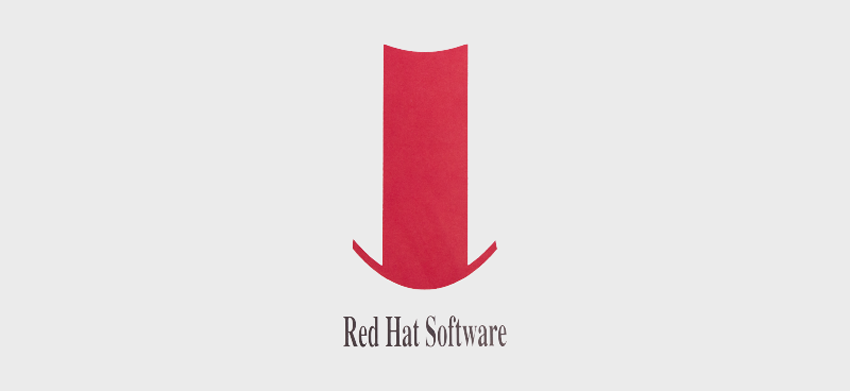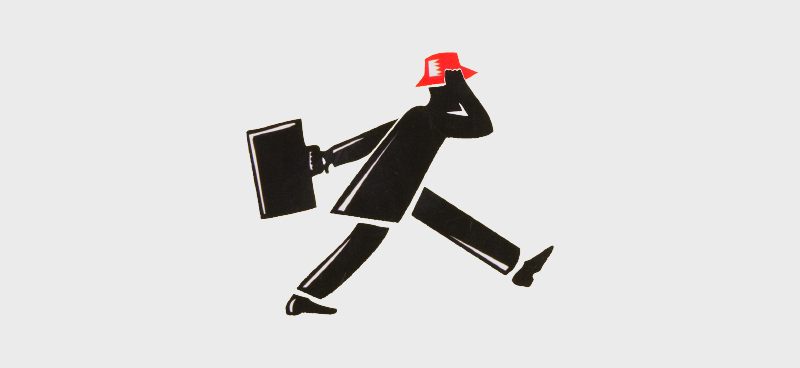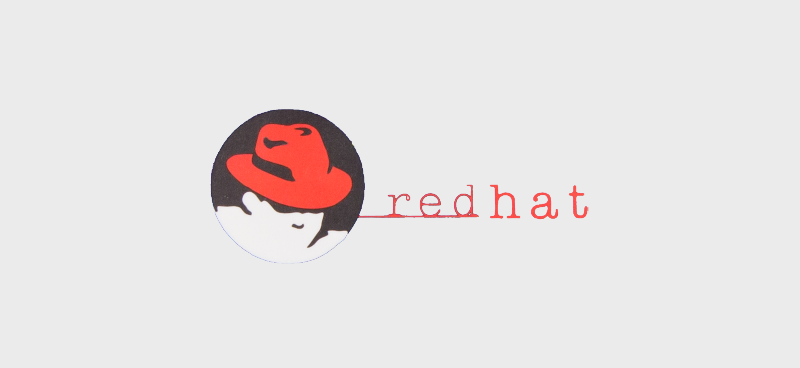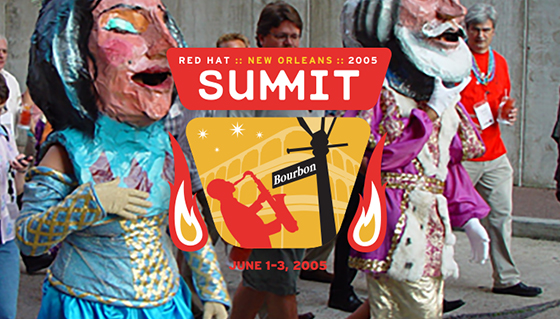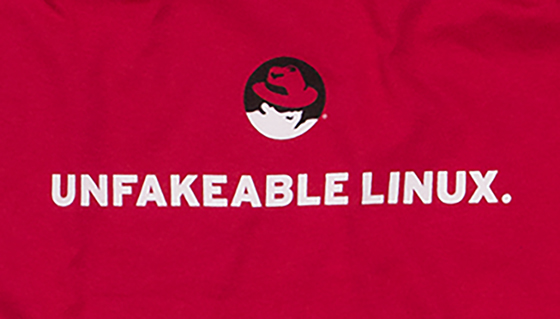Our history
1993-1999
Red Hat® Inc. began when a small businessman met a geek at a tech conference. Marc Ewing was the geek—hacking, debugging, and spinning his own distribution of Linux® on CDs from his home in Raleigh, North Carolina.
Bob Young was the businessman—running a computer supply catalog business out of his home in Connecticut. He noticed a growing interest in Linux, so he began to buy Ewing’s CDs. Young sold out of them so many times that he and Ewing joined forces, and Red Hat Software was born in 1995, with Young as CEO.
The name Red Hat came from Ewing’s experience in his college computer lab. He would wear his grandfather’s red Cornell lacrosse cap, and people would say, "If you need help, look for the guy in the red hat."
Red Hat's first logo appeared on an early invoice. It was a simple, bright red brimmed top hat placed above the words "Red Hat Software."
The next logo would be the "running man" logo, as it was affectionately known. This logo was used on early ads and manuals. It was created by one of Red Hat’s engineers, who modified a piece of existing clip art.
Instead of protecting trade secrets and filing patents for expensive proprietary products, Red Hat took a radically different approach to software: a stable, accessible distribution of a constantly evolving, community-developed operating system called Linux.
Red Hat believed that open collaboration was the best way to create software. It saw itself as an upstart charging the gates of a closed, monopolistic technology industry, and this view was represented in the creation of the Shadowman logo.
Part superhero, part rebel, and part private detective, Shadowman captured much of Red Hat’s early market strategy—sneaking past the barriers built by proprietary technology companies and bringing open source into datacenters.
As Red Hat grew, it became vital for the logo to be able to be registered as a trademark. The first Shadowman logo was created by Blank in 1996 and made its first public appearance in 1997.
When Red Hat went public in 1999 with a record-setting IPO, this newsworthy success validated Red Hat’s unwavering belief and trust in the power of open source. Shadowman was updated to "clean up" the icon and Red Hat was spelled in a more professional font.
2000-2006
For many years, Red Hat Linux was a boxed product sold alongside Microsoft Windows and Lotus Notes in retail stores. Like other software companies, Red Hat released a new version every six months or so—hoping customers would buy it for the new features. While the development model was innovative, the business model wasn’t.
In 2001, Red Hat stopped the distribution of boxed Red Hat Linux, its primary source of revenue. Instead, affirming its trust in open source once again, Red Hat introduced an enterprise edition that would be sold on a subscription basis.
Red Hat Enterprise Linux became the company’s flagship product, an offering to the world’s most demanding datacenters. A freely available, community version of its Linux operating system would continue to be developed and supported under a new name: Fedora.
Matthew Szulik, then CEO and a tireless open source evangelist, believed in Red Hat’s role as a catalyst for change in the technology industry. In 2006, he charted what would become Red Hat’s vision:
To be the defining technology company of the 21st century, and through our actions, strengthen the social fabric by continually democratizing content and technology.
Red Hat’s success with Red Hat Enterprise Linux led to steady growth, and investment and participation in other open source communities. As these communities crafted new technologies, the company added more features and capabilities and expanded their portfolio. Defining moments included the first Red Hat Summit in 2005 and the "Unfakeable Linux" response at Oracle OpenWorld in 2006.
Held for the first time in New Orleans in 2005, Red Hat Summit is a chance for Red Hat's customers, partners, and community to learn, network, and experience all that enterprise open source has to offer.
In 2006, Oracle released a clone of Red Hat Enterprise Linux it called "Unbreakable Linux" at Oracle OpenWorld. The next day, Red Hat distributed hundreds of T-shirts with a simple response: "Unfakeable Linux."
2007-2018
Jim Whitehurst became President and CEO of Red Hat in 2007. He initiated a new collaborative mission statement in 2009 that told the world not only of Red Hat’s dedication to open source but also to the open source way:
To be the catalyst in communities of customers, contributors, and partners creating better technology the open source way.
In 2012, Red Hat became the first open source technology company to surpass more than US$1 billion in revenue. In 2016, Red Hat exceeded US$2 billion in revenue.
The company’s tremendous growth and expanding portfolio precipitated an update of the corporate logo and brand systems. Red Hat was no longer an upstart "secret agent" of change, but the world’s leading provider of enterprise open source solutions.
In 2018, the Open Brand Project began the process of creating the Red Hat logo used today: an unambiguous, bold, bright red fedora that best reflects the company’s reputation of openness, inclusivity, authenticity, and helpfulness.
2019-Today
In 2019, Red Hat and IBM joined forces in one of the largest software acquisitions in history. The move aided Red Hat’s efforts to bring open source innovation to an even broader range of organizations and scale to meet the need for hybrid cloud solutions that deliver true choice and agility. But Red Hat is still Red Hat, operating as an independent subsidiary, guided by the same values and principles that have always guided its brand.
In early 2020, Paul Cormier was named President and CEO of Red Hat. His leadership solidified the company as an industry leader and paved the way for the open innovation that is at the heart of Red Hat’s open hybrid cloud strategy.
In July of 2022, Matt Hicks succeeded Cormier as President and CEO. Hicks previously served as Executive Vice President of Products and Technologies, where he was responsible for the entirety of Red Hat’s product strategy and engineering. With more than 25 years experience in Linux, a background in computer engineering, industry vision, and business acumen, Hicks is well-regarded for his work with customers and partners to solve the next generation of IT challenges with open source.
In 25+ years, Red Hat has grown from a small, home-based business into the world’s leading provider of enterprise open source solutions. Today, more than 90% of Fortune 500 companies rely on Red Hat, and its products and solutions are trusted on a global scale.
Starting with the revolutionary foundation of Red Hat Enterprise Linux, Red Hat has built a broad portfolio spanning a full, modern IT stack, including hybrid cloud infrastructure, middleware, agile integration, cloud-native application development, and management and automation solutions. As always, everything continues to be made the open source way.

